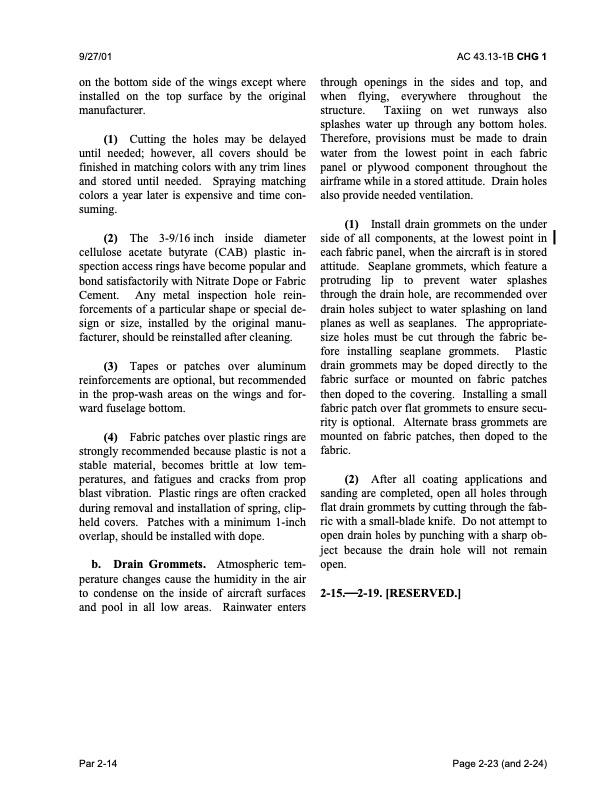
PDF Publication Title:
Text from PDF Page: 101
9/27/01 AC 43.13-1B CHG 1 on the bottom side of the wings except where installed on the top surface by the original manufacturer. (1) Cutting the holes may be delayed until needed; however, all covers should be finished in matching colors with any trim lines and stored until needed. Spraying matching colors a year later is expensive and time con suming. (2) The 3-9/16 inch inside diameter cellulose acetate butyrate (CAB) plastic in spection access rings have become popular and bond satisfactorily with Nitrate Dope or Fabric Cement. Any metal inspection hole rein forcements of a particular shape or special de sign or size, installed by the original manu facturer, should be reinstalled after cleaning. (3) Tapes or patches over aluminum reinforcements are optional, but recommended in the prop-wash areas on the wings and for ward fuselage bottom. (4) Fabric patches over plastic rings are strongly recommended because plastic is not a stable material, becomes brittle at low tem peratures, and fatigues and cracks from prop blast vibration. Plastic rings are often cracked during removal and installation of spring, clip- held covers. Patches with a minimum 1-inch overlap, should be installed with dope. b. Drain Grommets. Atmospheric tem perature changes cause the humidity in the air to condense on the inside of aircraft surfaces and pool in all low areas. Rainwater enters through openings in the sides and top, and when flying, everywhere throughout the structure. Taxiing on wet runways also splashes water up through any bottom holes. Therefore, provisions must be made to drain water from the lowest point in each fabric panel or plywood component throughout the airframe while in a stored attitude. Drain holes also provide needed ventilation. (1) Install drain grommets on the under side of all components, at the lowest point in each fabric panel, when the aircraft is in stored attitude. Seaplane grommets, which feature a protruding lip to prevent water splashes through the drain hole, are recommended over drain holes subject to water splashing on land planes as well as seaplanes. The appropriate- size holes must be cut through the fabric be fore installing seaplane grommets. Plastic drain grommets may be doped directly to the fabric surface or mounted on fabric patches then doped to the covering. Installing a small fabric patch over flat grommets to ensure secu rity is optional. Alternate brass grommets are mounted on fabric patches, then doped to the fabric. (2) After all coating applications and sanding are completed, open all holes through flat drain grommets by cutting through the fab ric with a small-blade knife. Do not attempt to open drain holes by punching with a sharp ob ject because the drain hole will not remain open. 2-15.2-19. [RESERVED.] Par 2-14 Page 2-23 (and 2-24)PDF Image | AFS-640

PDF Search Title:
AFS-640Original File Name Searched:
ac_43.13-1b_w-chg1.pdfDIY PDF Search: Google It | Yahoo | Bing
5,000 BF Shipping Container Lumber Dry Kiln For Quality Lumber The 5,000 BF container kiln consists of one 40 foot high-cube aluminum shipping container... More Info
Shipping Container Lumber Dry Kilns by Global Energy Global Energy designed and developed the container kiln back in 1991. The purpose is to give access to portable sawmill owners, furniture makers, and small business the value added profit of dry kiln lumber and quality hardwoods... More Info
Vacuum Kiln Conversion Kit for Lumber and Wood Dry Kilns Convert your existing conventional dry kiln into a fast drying vacuum kiln. Similar to vacuum bagging in the boat building and aircraft industry, we have come up with a proprietary process which allows you to build a very simple vacuum kiln at a fraction of the price, and without the intensive conventional metal chamber structure... More Info
Vacuum Pump Cart System for Bagging Clamping Wood Drying and more Vacuum Cart with 2HP Pump and Dual Pistons with multiple multiplex vacuum ports and liquid reservoir... More Info
Vacuum Bagging Basics Vacuum bagging is a method of clamping, which has traditionally been used in the composites industry, but can also be used for vacuum drying materials, including wood products... More Info
| CONTACT TEL: 608-238-6001 Email: greg@globalmicroturbine.com | RSS | AMP |